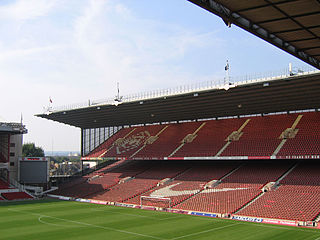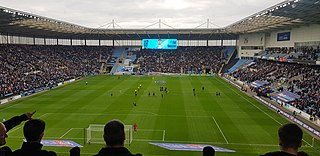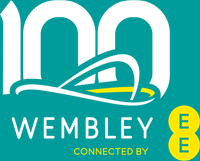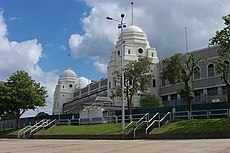
Arsenal Stadium was a football stadium in Highbury, London, which was the home of Arsenal Football Club between 6 September 1913 and 7 May 2006. It was popularly known as "Highbury" from the name of the district in which it was located, and was given the affectionate nickname of "The Home of Football".

Stadium Australia, currently known as Accor Stadium for sponsorship reasons, is a multi-purpose stadium located in the suburb of Sydney Olympic Park, Sydney, New South Wales, Australia. The stadium, which is sometimes referred to as Sydney Olympic Stadium, Homebush Stadium or simply the Olympic Stadium, was completed in March 1999 at a cost of A$690 million to host the 2000 Summer Olympics. The Stadium was leased by a private company, the Stadium Australia Group, until the Stadium was sold back to the NSW Government on 1 June 2016 after NSW Premier Michael Baird announced the Stadium was to be redeveloped as a world-class rectangular stadium. The Stadium is owned by Venues NSW on behalf of the NSW Government.

The National Sports Centre at Crystal Palace in south London, England is a large sports centre and outdoor athletics stadium. It was opened in 1964 in Crystal Palace Park, close to the site of the former Crystal Palace Exhibition building which had been destroyed by fire in 1936, and is on the same site as the former FA Cup Final venue which was used here between 1895 and 1914.

The Grand Sports Arena of the Luzhniki Olympic Complex, commonly known as Luzhniki Stadium, is the national stadium of Russia, located in its capital city, Moscow. Its total seating capacity of 78,011 makes it the largest football stadium in Russia and the ninth-largest stadium in Europe. The stadium is a part of the Luzhniki Olympic Complex, and is located in Khamovniki District of the Central Administrative Okrug of Moscow city. The name Luzhniki derives from the flood meadows in the bend of Moskva River where the stadium was built, translating roughly as "The Meadows". The stadium is located at Luzhniki Street, 24, Moscow.

Wembley Arena (originally the Empire Pool, now known as OVO Arena Wembley for sponsorship reasons) is an indoor arena next to Wembley Stadium in Wembley, London, England. The 12,500-seat facility is London's second-largest indoor arena after the O2 Arena, and the ninth-largest in the United Kingdom.

Elland Road, also called Elland Road Football Stadium or Elland Road Stadium, is a football stadium in Beeston, Leeds, West Yorkshire, England, which has been the home of Championship club Leeds United since the club's formation in 1919. The stadium is the 13th largest football stadium in England.

The Millennium Stadium, known since 2016 as the Principality Stadium for sponsorship reasons, is the national stadium of Wales. Located in Cardiff, it is the home of the Wales national rugby union team and has also held Wales national football team games. Initially built to host the 1999 Rugby World Cup and replacing the National Stadium, it has gone on to host many other large-scale events, such as the Tsunami Relief Cardiff concert, the Super Special Stage of Wales Rally Great Britain, the Speedway Grand Prix of Great Britain and various concerts. It also hosted FA Cup, League Cup and Football League play-off finals while Wembley Stadium was being redeveloped between 2001 and 2006, as well as football matches during the 2012 Summer Olympics.

Twickenham Stadium in Twickenham, in the London Borough of Richmond upon Thames, England, is a rugby union stadium owned by the Rugby Football Union (RFU), English rugby union governing body, which has its headquarters there. The stadium is England's national rugby union stadium and is the venue of the England national rugby union team home matches.

White City Stadium in London, England, was built for the 1908 Summer Olympics. It hosted the finish of the first modern marathon and swimming, speedway, boxing, show jumping, athletics, stock car racing, concerts and a match at the 1966 World Cup.

Murrayfield Stadium is a rugby union stadium located in the Murrayfield area of Edinburgh, Scotland. The stadium is owned by the Scottish Rugby Union (SRU) who has its headquarters based at the stadium, and is the national stadium of the Scotland national rugby union team. With a seating capacity of 67,144, it is the largest stadium in Scotland, the fifth largest in the United Kingdom, and the twenty–second largest in Europe.

Hong Kong Stadium is the main sports venue of Hong Kong. Redeveloped from the original Government Stadium, it reopened as Hong Kong Stadium in March 1994. It has a maximum seating capacity of 40,000, including 18,260 at the main level, 3,173 at executive level, 18,510 upper-level seats and 57 seats for wheelchair users.

Wellington Regional Stadium is a major sporting venue in Wellington, New Zealand. The stadium's bowl site size is 48,000 m2 (520,000 sq ft).

Wembley Park is a district of the London Borough of Brent, England. It is roughly centred on Bridge Road, a mile northeast of Wembley town centre and 7.6 miles (12 km) northwest from Charing Cross.

The Coventry Building Society Arena is a complex in Coventry, West Midlands, England. It includes a 32,609-seater stadium which is currently home to football team, Championship club Coventry City F.C. along with facilities which include a 6,000 square metres (65,000 sq ft) exhibition hall, a hotel and a casino. The site is also home to Arena Park Shopping Centre, containing one of UK's largest Tesco Extra hypermarkets. Built on the site of the Foleshill gasworks, it is named after its sponsor, Coventry Building Society who entered into a ten-year sponsorship deal in 2021. For the 2012 Summer Olympics, where stadium naming sponsorship was forbidden, the stadium was known as the City of Coventry Stadium.

Odsal Stadium in Bradford, West Yorkshire, England, is a multi-purpose stadium currently the home of Bradford Bulls Rugby League team and Yorstox Stock Cars who host regular monthly meetings of BriSCA F1 Stock Cars and BriSCA F2 Stock Cars. It has also been used by the Bradford Dukes speedway team, hosting the 1997 Speedway Grand Prix of Great Britain. The football team Bradford City used Odsal as a temporary groundshare following the Valley Parade fire while their ground was rebuilt. Odsal Stadium has also historically hosted baseball, women's football, American football, basketball, kabbadi, show jumping, tennis, live music concerts, and international Rugby League matches over the years.
In London, a diverse array of athletics stretching from football to tennis have further granted its city the spotlight throughout the world. London has hosted the Olympic Games in 1908, 1948, and most recently in 2012, making it the most frequently chosen city in modern Olympic history. Other popular sports in London include cricket, rowing, rugby, basketball, and most recently American Football.

The Boulevard was a multi-purpose stadium in Hull, England, from 1895 to 2010. The venue primarily hosted rugby league matches, speedway and greyhound racing.

Wembley Stadium is an association football stadium in Wembley, London. It opened in 2007 on the site of the original Wembley Stadium, which had stood from 1923 until 2003. The stadium is England's national football stadium, and thus hosts the majority of the England national team home matches and the FA Cup Final – the final of England's primary domestic club football competition. It is widely regarded as one of the most iconic football stadiums in the world, and is considered a hub for the English game. Wembley Stadium is owned by the governing body of English football, the Football Association, whose headquarters are in the stadium, through its subsidiary Wembley National Stadium Ltd (WNSL). With 90,000 seats, it is the largest stadium in the UK and the second-largest stadium in Europe, behind Barcelona's Camp Nou.
Manchester City and Manchester United are popular Premier League football clubs in Greater Manchester. United's ground is in Old Trafford; Manchester City's home ground is the City of Manchester Stadium in east Manchester. Fixtures between the clubs are referred to as the Manchester Derby. Manchester United are historically the second most successful football club in England with 67 elite honours won and was the first team in England to achieve the Continental treble. Manchester United's revenue was the fifth highest of a football club in the world in the 2022–23 season at €745.8 million. In 2023, Forbes estimated the club was the second most valuable in the world at $6 billion.

Sir Arthur Elvin was a British businessman who was best known as the owner and operator of Wembley Stadium, London, and supporter of the 1948 Olympic Games.


































